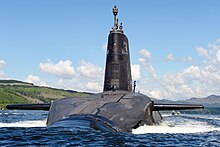
Back برنامج ترايدنت النووي Arabic ট্রাইডেন্ট (যুক্তরাজ্যের পারমাণবিক কর্মসূচি) Bengali/Bangla Trident Esperanto Trident (programa nuclear del Reino Unido) Spanish Programme nucléaire britannique Trident French Программа «Трайдент» Russian
| Trident | |
|---|---|
 HMS Victorious, a Trident missile-armed Vanguard-class submarine leaving its base at HMNB Clyde on a training exercise in 2013 | |
| Type of project | Deployment of Trident ballistic missile submarines |
| Country | United Kingdom |
| Established | 1980 |
Trident, also known as the Trident nuclear programme or Trident nuclear deterrent, covers the development, procurement and operation of nuclear weapons in the United Kingdom and their means of delivery. Its purpose as stated by the Ministry of Defence is to "deter the most extreme threats to our national security and way of life, which cannot be done by other means".[1] Trident is an operational system of four Vanguard-class submarines armed with Trident II D-5 ballistic missiles, able to deliver thermonuclear warheads from multiple independently targetable re-entry vehicles (MIRVs). It is operated by the Royal Navy and based at Clyde Naval Base on the west coast of Scotland. At least one submarine is always on patrol to provide a continuous at-sea capability. The missiles are manufactured in the United States, while the warheads are British.
The British government initially negotiated with the Carter administration for the purchase of the Trident I C-4 missile. In 1981, the Reagan administration announced its decision to upgrade its Trident to the new Trident II D-5 missile. This necessitated another round of negotiations and concessions. The UK Trident programme was announced in July 1980 and patrols began in December 1994. Trident replaced the submarine-based Polaris system, in operation from 1968 until 1996. Trident is the only nuclear weapon system operated by the UK since the decommissioning of tactical WE.177 free-fall bombs in 1998.
NATO's military posture was relaxed after the collapse of the Soviet Union in 1991. Trident warheads have never been aimed at specific targets on an operational patrol, but await co-ordinates that can be programmed into their computers and fired with several days' notice. Although Trident was designed as a strategic deterrent, the end of the Cold War led the British government to conclude that a sub-strategic—but not tactical—role was required.
A programme for the replacement of the Vanguard class is under way. On 18 July 2016, the House of Commons voted by a large majority to proceed with building a fleet of Dreadnought-class submarines, to be operational by 2028, with the current fleet completely phased out by 2032.
- ^ "UK nuclear deterrence: what you need to know". Ministry of Defence. 26 February 2016. Archived from the original on 21 September 2016. Retrieved 1 March 2016.